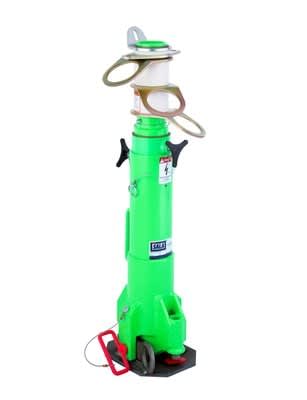A few points to consider:
IBC 2018 1607.10.4 said:
Fall arrest and lifeline anchorages.
In addition to any other applicable live loads, fall arrest and lifeline anchorages and structural elements that support these anchorages shall be esigned for a live load of not less than 3,100 pounds (13.8 kN) for each attached lifeline, in every direction that a fall arrest load can be applied.
OSHA 1910.140(c)(5) said:
Self-retracting lifelines and lanyards that automatically limit free fall distance to 2 feet (0.61 m) or less must have components capable of sustaining a minimum tensile load of 3,000 pounds (13.3 kN) applied to the device with the lifeline or lanyard in the fully extended position.
OSHA 1910.140(c)(7) said:
D-rings, snaphooks, and carabiners must be capable of sustaining a minimum tensile load of 5,000 pounds (22.2 kN).
OSHA 1910.140(c)(8) said:
D-rings, snaphooks, and carabiners must be proof tested to a minimum tensile load of 3,600 pounds (16 kN) without cracking, breaking, or incurring permanent deformation. The gate strength of snaphooks and carabiners must be capable of withstanding a minimum load of 3,600 pounds (16 kN) without the gate separating from the nose of the snaphook or carabiner body by more than 0.125 inches (3.175 mm).
1910.140(c)(13) said:
Anchorages, except window cleaners' belt anchors covered by paragraph (e) of this section, must be:
1910.140(c)(13)(i)
Capable of supporting at least 5,000 pounds (22.2 kN) for each employee attached; or
1910.140(c)(13)(ii)
Designed, installed, and used, under the supervision of qualified person, as part of a complete personal fall protection system that maintains a safety factor of at least two.
1910.140(d)(2)(ii) said:
Personal fall arrest systems are rigged in such a manner that the employee cannot free fall more than 6 feet (1.8 m) or contact a lower level. A free fall may be more than 6 feet (1.8 m) provided the employer can demonstrate the manufacturer designed the system to allow a free fall of more than 6 feet and tested the system to ensure a maximum arresting force of 1,800 pounds (8 kN) is not exceeded.
So the only source for the 5,000 lb load is OSHA. And OSHA does not define whether this is meant to be an ultimate load or a service load. It only says "capable of supporting." To me, this sounds like an upper limit. It doesn't need to be "capable of supporting 5,000lbs
with a safety factor of at least two"...it just says capable of 5,000lbs. So if you're using 5,000lbs, it should be an ultimate load. If it fails at 5,001lbs...that's okay. Because it was capable of supporting 5,000lbs. It's also worth noting that this is only the anchorage - you can conservatively argue that this load should be carried through the entire load path, but I don't think it needs to be. Just like impact vibrations aren't chased further than the girder supporting the impacted joist and blast load anchorage forces aren't typically chased through the whole load path, there's no need to do it here. Make sure your anchor is attached with a connection that meets the 5,000lb (ultimate) load and then follow a more reasonable load through the rest of the load path.
That more reasonable load comes from the IBC (and also meets the requirements of OSHA for design by a qualified person). If you look at the maximum allowable arresting force - 1,800lbs - that's the peak load experienced by a worker falling 6 feet or less. If there is tension greater than that, your system has already "failed" (1,800lbs is 5.8x the weight of a combined weight of worker and tools of 310lbs). So IBC says you have to design for at least 2x the maximum tensile force in the system: 3,600lbs. That's effectively a "service" load. Of course, this actually gives you a safety factor
greater than two as it doesn't consider material safety factors used for development of allowable stresses or the combined effect of load and resistance factors in arriving at an effective safety factor. But it's quick and easy and conservative.
So, for a fall arrest anchor that a worker is tied to directly, I say design the connection for 5,000lbs (ultimate) to satisfy OSHA, and then design the structural response for at least 3,600lbs (service) to satisfy the IBC and OSHA. Increase if designed for multiple workers.
If you are looking at a horizontal lifeline, it's a totally different story - those loads can get extreme fast, and you really have to consider energy absorption devices and their ability to cut peak loads to the anchorage to have a change at making it work. I've considered energy absorption and deflection of the lifeline itself before to keep the numbers manageable.

